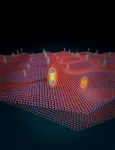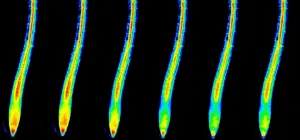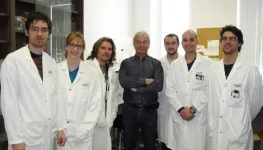Moiré effect: How to twist material properties
2D materials have triggered a boom in materials research. Now it turns out that exciting effects occur when two such layered materials are stacked and slightly twisted
2021-03-23
(Press-News.org) The discovery of the material graphene, which consists of only one layer of carbon atoms, was the starting signal for a global race: Today, so-called "2D materials" are produced, made of different types of atoms. Atomically thin layers that often have very special material properties not found in conventional, thicker materials.
Now another chapter is being added to this field of research: If two such 2D layers are stacked at the right angle, even more new possibilities arise. The way in which the atoms of the two layers interact creates intricate geometric patterns, and these patterns have a decisive impact on the material properties, as a research team from TU Wien and the University of Texas (Austin) has now been able to show. Phonons - the lattice vibrations of the atoms - are significantly influenced by the angle at which the two material layers are placed on top of each other. Thus, with tiny rotations of such a layer, one can significantly change the material properties.
The Moiré Effect
The basic idea can be tried out at home with two fly screen sheets - or with any other regular meshes that can be placed on top of each other: If both grids are perfectly congruent on top of each other, you can hardly tell from above whether it is one or two grids. The regularity of the structure has not changed.
But if you now turn one of the grids by a small angle, there are places where the gridpoints of the meshes roughly match, and other places where they do not. This way, interesting patterns emerge - that is the well-known moiré effect.
"You can do exactly the same thing with the atomic lattices of two material layers," says Dr. Lukas Linhart from the Institute for Theoretical Physics at TU Wien. The remarkable thing is that this can dramatically change certain material properties - for example, graphene becomes a superconductor if two layers of this material are combined in the right way.
"We studied layers of molybdenum disulphide, which, along with graphene, is probably one of the most important 2D materials," says Prof Florian Libisch, who led the project at TU Wien. "If you put two layers of this material on top of each other, so-called Van der Waals forces occur between the atoms of these two layers. These are relatively weak forces, but they are strong enough to completely change the behaviour of the entire system."
In elaborate computer simulations, the research team analysed the quantum mechanical state of the new bilayer structure caused by these weak additional forces, and how this affects the vibrations of the atoms in the two layers.
The angle of rotation matters
"If you twist the two layers a little bit against each other, the Van der Waals forces cause the atoms of both layers to change their positions a little bit," says Dr Jiamin Quan, from UT Texas in Austin. He led the experiments in Texas, which confirmed the results of the calculations: The angle of rotation can be used to adjust which atomic vibrations are physically possible in the material.
"In terms of materials science, it is an important thing to have control over phonon vibrations in this way," says Lukas Linhart "The fact that electronic properties of a 2D material can be changed by joining two layers together was already known before. But the fact that the mechanical oscillations in the material can also be controlled by this now opens up new possibilities for us. Phonons and electromagnetic properties are closely related. Via the vibrations in the material, one can therefore intervene in important many-body effects in a controlling way." After this first description of the effect for phonons, the researchers are now trying to describe phonons and electrons combined, hoping to learn more about important phenomena like superconductivity.
The material-physical Moiré effect thus makes the already rich research field of 2D materials even richer - and increases the chances of continuing to find new layered materials with previously unattainable properties and enables the use of 2D materials as an experimental platform for quite fundamental properties of solids.
INFORMATION:
Contact
Prof. Florian Libisch
Institute for Theoretical Physics
TU Wien
Wiener Hauptstraße 8-10, Vienna
T +43-1-58801-13608
florian.libisch@tuwien.ac.at
Dr. Lukas Linhart
Institute for Theoretical Physics
TU Wien
Wiener Hauptstraße 8-10, Vienna
T +43-1-58801-13655
lukas.linhart@tuwien.ac.at
[Attachments] See images for this press release:

ELSE PRESS RELEASES FROM THIS DATE:
2021-03-23
The possibly oldest cephalopods in the earth's history stem from the Avalon Peninsula in Newfoundland (Canada). They were discovered by earth scientists from Heidelberg University. The 522 million-year-old fossils could turn out to be the first known form of these highly evolved invertebrate organisms, whose living descendants today include species such as the cuttlefish, octopus and nautilus. In that case, the find would indicate that the cephalopods evolved about 30 million years earlier than has been assumed.
"If they should actually be cephalopods, we would have to backdate the origin of cephalopods into the early Cambrian period," says Dr Anne Hildenbrand ...
2021-03-23
Russian scientists have proposed a new algorithm for automatic decoding and interpreting the decoder weights, which can be used both in brain-computer interfaces and in fundamental research. The results of the study were published in the Journal of Neural Engineering.
Brain-computer interfaces are needed to create robotic prostheses and neuroimplants, rehabilitation simulators, and devices that can be controlled by the power of thought. These devices help people who have suffered a stroke or physical injury to move (in the case of a robotic chair or prostheses), communicate, use a computer, and operate household appliances. In addition, in combination with machine learning methods, neural interfaces ...
2021-03-23
In the hours after we die, certain cells in the human brain are still active. Some cells even increase their activity and grow to gargantuan proportions, according to new research from the University of Illinois Chicago.
In a newly published study in the journal Scientific Reports, the UIC researchers analyzed gene expression in fresh brain tissue -- which was collected during routine brain surgery -- at multiple times after removal to simulate the post-mortem interval and death. They found that gene expression in some cells actually increased after death.
These 'zombie genes' -- those that increased expression after the post-mortem interval -- were specific to one type of cell: inflammatory cells called ...
2021-03-23
Potassium is an essential nutrient for all living things. Plants need it in large quantities, especially for growth and in order to withstand stress better. For this reason, they absorb large quantities of potassium from the soil. In agriculture, this leads to a lack of available potassium in the soil - which is why the mineral is an important component in fertilizers. A team of German and Chinese researchers has now shown, for the first time, where and how plants detect potassium deficiency in their roots, and which signalling pathways coordinate the adaptation of root growth and potassium absorption ...
2021-03-23
A number of studies have shown that human coronaviruses, including SARS-CoV-2 which causes COVID-19, appear to attack neurons and the nervous system in vulnerable populations. This neuroinvasion through the nasal cavity leads to the risk of neurological disorders in affected individuals. Research conducted at the Institut national de la recherche scientifique (INRS) has identified ways to prevent the spread of infection within the central nervous system (CNS). The study, led by Professor Pierre Talbot and his research associate Marc Desforges, now at CHU-Sainte-Justine, ...
2021-03-23
According to a recent Finnish study, accumulating more brisk and vigorous physical activity can curb adiposity-induced low-grade inflammation. The study also reported that diet quality had no independent association with low-grade inflammation. The findings, based on the ongoing Physical Activity and Nutrition in Children (PANIC) Study conducted at the University of Eastern Finland, were published in the European Journal of Sport Science.
The study was made in collaboration among researchers from the University of Jyväskylä, the University of Eastern Finland, the Norwegian School of Sport Sciences, and the University of Cambridge.
Low-grade inflammation is linked to many chronic diseases, but exercise can ...
2021-03-23
Casual sex is on the decline for both young men and women, according to a Rutgers University-New Brunswick study that found less alcohol consumption among both genders is a major reason while playing video games and living at home with parents are another--but only for men.
The study, published in the journal Socius, found that between 2007 and 2017, the percentage of 18-to 23-year-old men who had casual sex in the past month dropped from 38 percent to 24 percent. The percentage dropped from 31 percent to 22 percent for young women of the same age.
The most important factor driving the decline among young men is the decrease in drinking, which alone explains more than ...
2021-03-23
The vast reservoir of carbon that is stored in soils probably is more sensitive to destabilization from climate change than has previously been assumed, according to a new study by researchers at WHOI and other institutions.
The study found that the biospheric carbon turnover within river basins is vulnerable to future temperature and precipitation perturbations from a changing climate.
Although many earlier, and fairly localized, studies have hinted at soil organic carbon sensitivity to climate change, the new research sampled 36 rivers from around the ...
2021-03-23
As the pandemic's economic effects drive more people to enroll in Medicaid as safety-net health insurance, a new study suggests that the program's dental coverage can improve their oral health in ways that help them seek a new job or do better at the one they have.
The study focuses on the impact of dental coverage offered through Michigan's Medicaid expansion, called the Healthy Michigan Plan. The researchers, from the University of Michigan, used a survey and interviews to assess the impact of this coverage on the health and lives of low-income people who enrolled.
In all, 60% of the 4,090 enrollees surveyed for the new study had visited a dentist at least once since enrolling ...
2021-03-23
Daily national surveys by Carnegie Mellon University show that while COVID-19 vaccine uptake has increased, the proportion of vaccine-hesitant adults has remained unchanged. The concerns about a side effect remain high, especially among females, Black adults and those with an eligible health condition.
The Delphi Research Group at CMU in partnership with Facebook released its latest survey findings. The analyses show that vaccine hesitancy persists and point to potential tactics to combat it.
"Prior research by the CDC has found that Black and Hispanic adults are the least likely to receive the annual flu vaccine each year," said Alex Reinhart, assistant teaching professor in CMU's Department of Statistics & Data Science and a member of the Delphi ...
LAST 30 PRESS RELEASES:
[Press-News.org] Moiré effect: How to twist material properties
2D materials have triggered a boom in materials research. Now it turns out that exciting effects occur when two such layered materials are stacked and slightly twisted







